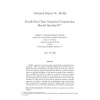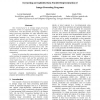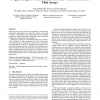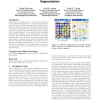IPPS
1998
IEEE
14 years 3 months ago
1998
IEEE
Parallel programming continues to be difficult and error-prone, whether starting from specifications or from an existing sequential program. This paper presents (1) a methodology f...
PADS
1999
ACM
14 years 3 months ago
1999
ACM
This paper introduces the Critical Channel Traversing (CCTJ algorithm, a new scheduling algorithm for both sequential and parallel discrete event simulation. CCT is a general cons...
ITCC
2000
IEEE
14 years 3 months ago
2000
IEEE
Parallel computers can do more than simply speed up sequential computations. They are capable of nding solutions that are far better in quality than those obtained by sequential c...
WCRE
2002
IEEE
14 years 4 months ago
2002
IEEE
As new computer architectures are developed to exploit large-scale data-level parallelism, techniques are needed to retarget legacy sequential code to these platforms. Sequential ...
WCRE
2003
IEEE
14 years 4 months ago
2003
IEEE
Our research goal is to retarget image processing programs written in sequential languages (e.g., C) to architectures with data-parallel processing capabilities. Image processing ...
VTS
2003
IEEE
14 years 4 months ago
2003
IEEE
: This paper presents a novel, low cost technique based on implications to identify untestable bridging faults in sequential circuits. Sequential symbolic simulation [1] is first p...
PPOPP
2006
ACM
14 years 5 months ago
2006
ACM
Tiling has proven to be an effective mechanism to develop high performance implementations of algorithms. Tiling can be used to organize computations so that communication costs i...
MHCI
2007
Springer
14 years 5 months ago
2007
Springer
In this paper, we explore the use of an interaction technique called sequential segmentation to support target selection for mobile devices. Sequential segmentation iteratively pa...




